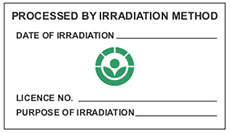The note has detailed information on irradiation technology, its benefits, food irradiation facilities in India, public perception, commercial prospects in India and use of irradiation technology globally.
Irradiation is a physical process in which food commodities like bulk or pre-packaged are exposed to controlled doses of energy of ionising radiation such as gamma rays or X-rays to achieve different technological objectives.
The note stresses on the fact that radiation technology can be termed as one process with multiple uses. The application of food irradiation on the basis of dose requirements like low, medium and high can help in extension of shelf-life, destruction of storage and quarantine insect pests, and killing of parasites, pathogens and spoilage microorganisms.
In India, regulations on radiation processing have been notified under Food Safety and Standards (Food Products Standards and Food Additives) Amendment Regulations, 2016. Further, as per FSS (Food Products Packaging and Labelling) Regulations, 2011, irradiated products are labelled and can be identified with the 'Radura' logo in a typical label:

In this regard, V P Venugopalan,head, nuclear agriculture and biotechnology division, associate director (A), bioscience group, Bhabha Atomic Research Centre (BARC), Trombay, states, "Radiation processing of food and agricultural produce is a very underutilised technology as far as India is concerned. It can help the country cut down post-harvest losses in a significant way. There are lots of misconceptions regarding the safety of irradiated food among the general public; added to that there is a general shortage of adequate irradiation facilities."
He added, "The guidance note issued by FSSAI provides, in a nutshell, information about the usefulness of radiation processing as a safe, convenient and economic method of food preservation. It also contains a very useful FAQ section that explains, in simple language, what the whole idea of food irradiation is about."
According to the note, there has been a problem of perception with the radiation technology. The confusion begins with the general inability of people to differentiate between the process of irradiation and the radioactivity as a contaminant in food. It is important for public to know that radiation processing facilities have inbuilt safety features that prevent human exposure to radiation. Irradiated foods are available in several countries.
Food irradiation is permitted in more than 60 countries and the volume of food processed by radiation for value addition is increasing. China, followed by USA, is the major user of the technology. Spices, dry vegetable seasonings, meat and meat products, herbs and herbal products, fresh fruits and vegetables are currently the major commodity groups where irradiation technology is frequently used. In irradiated fresh fruits and vegetable category, USA (mainland) and New Zealand are the largest importers, while US (state of Hawaii), Australia, Mexico, Vietnam, Thailand, and India are the major exporters.







